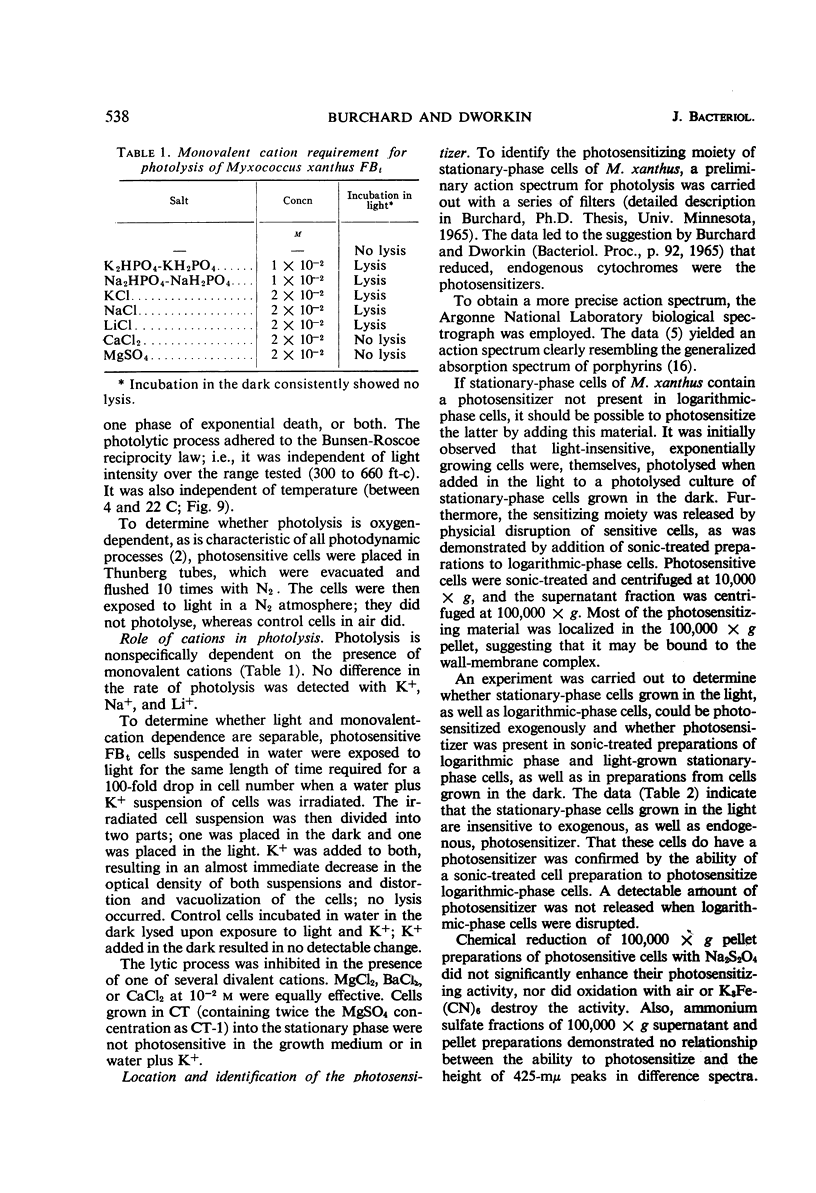Abstract
Burchard, Robert P. (University of Minnesota, Minneapolis), and Martin Dworkin. Light-induced lysis and carotenogenesis in Myxococcus xanthus. J. Bacteriol. 91:535–545. 1966.—Myxococcus xanthus, grown vegetatively in the light, developed an orange carotenoid after the cells entered stationary phase of growth; pigment content increased with age. Cells grown in the dark did not develop carotenoid and could be photolysed by relatively low-intensity light only during stationary phase; rate of photolysis increased with age. Photolysis adhered to the reciprocity law, was temperature-independent and oxygen-dependent, and required the presence of nonspecific, monovalent cations; it was inhibited by one of several divalent cations. Logarithmic-phase cells were photosensitized by 100,000 × g pellet preparations of sonic-treated stationary-phase cells grown in the light and dark. A porphyrin with a Soret band at 408 mμ was isolated from photosensitive cells; logarithmic-phase cells contained about 1/16 the amount of porphyrin of stationary-phase cells. The purified material had spectral and chemical properties of protoporphyrin IX and photosensitized logarithmic-phase cells. Its spectrum was similar to the action spectrum for photolysis. We concluded that protoporphyrin IX is the natural endogenous photosensitizer. Carotenogenesis was stimulated by light in the blue-violet region of the visible spectrum and was inhibited by diphenylamine, resulting in photosensitivity of the cells. Photoprotection by carotenoid was lost in the cold. A mutant which synthesized carotenoid in the light and dark was photosensitive only after growth in diphenylamine. The ecological significance of these phenomena is discussed.
Full text
PDF










Selected References
These references are in PubMed. This may not be the complete list of references from this article.
- BAMJI M. S., KRINSKY N. I. CAROTENOID DE-EPOXIDATIONS IN ALGAE. II. ENZYMATIC CONVERSION OF ANTHERAXANTHIN TO ZEAXANTHIN. J Biol Chem. 1965 Jan;240:467–470. [PubMed] [Google Scholar]
- BOGORAD L., GRANICK S. Protoporphyrin precursors produced by a Chlorella mutant. J Biol Chem. 1953 Jun;202(2):793–800. [PubMed] [Google Scholar]
- BROWN A. D. THE PERIPHERAL STRUCTURES OF GRAM-NEGATIVE BACTERIA.IV. THE CATION-SENSITIVE DISSOLUTION OF THE CELL MEMBRANE OF THE HALOPHILIC BACTERIUM, HALOBACTERIUM HALOBIUM. Biochim Biophys Acta. 1963 Nov 29;75:425–435. doi: 10.1016/0006-3002(63)90630-9. [DOI] [PubMed] [Google Scholar]
- Burchard R. P., Gordon S. A., Dworkin M. Action spectrum for the photolysis of Myxococcus xanthus. J Bacteriol. 1966 Feb;91(2):896–897. doi: 10.1128/jb.91.2.896-897.1966. [DOI] [PMC free article] [PubMed] [Google Scholar]
- DUNDAS I. D., LARSEN H. A STUDY ON THE KILLING BY LIGHT OF PHOTOSENSITIZED CELLS OF HALOBACTERIUM SALINARIUM. Arch Mikrobiol. 1963 Jul 18;46:19–28. doi: 10.1007/BF00406383. [DOI] [PubMed] [Google Scholar]
- DWORKIN M. Function of carotenoids in photosynthetic bacteria. Nature. 1959 Dec 12;184(Suppl 24):1891–1892. doi: 10.1038/1841891b0. [DOI] [PubMed] [Google Scholar]
- DWORKIN M., NIEDERPRUEM D. J. ELECTRON TRANSPORT SYSTEM IN VEGETATIVE CELLS AND MICROCYSTS OF MYXOCOCCUS XANTHUS. J Bacteriol. 1964 Feb;87:316–322. doi: 10.1128/jb.87.2.316-322.1964. [DOI] [PMC free article] [PubMed] [Google Scholar]
- DWORKIN M. Nutritional requirements for vegetative growth of Myxococcus xanthus. J Bacteriol. 1962 Aug;84:250–257. doi: 10.1128/jb.84.2.250-257.1962. [DOI] [PMC free article] [PubMed] [Google Scholar]
- FELDMAN L. A., LINDSTROM E. S. THE EFFECT OF CAROTENOID PIGMENTS ON PHOTOOXIDATIONS OF SOME PHOTOSYNTHETIC BACTERIA. Biochim Biophys Acta. 1964 Mar 30;79:266–272. [PubMed] [Google Scholar]
- GOODWIN T. W., OSMAN H. G. Studies in carotenogenesis. 9. General cultural conditions controlling carotenoid (spirilloxanthin) synthesis in the photosynthetic bacterium Rhodospirillum rubrum. Biochem J. 1953 Mar;53(4):541–546. doi: 10.1042/bj0530541. [DOI] [PMC free article] [PubMed] [Google Scholar]
- GRIFFITHS M., SISTROM W. R., COHENBAZIRE G., STANIER R. Y., CALVIN M. Function of carotenoids in photosynthesis. Nature. 1955 Dec 24;176(4495):1211–1215. doi: 10.1038/1761211a0. [DOI] [PubMed] [Google Scholar]
- MASON D. J., POWELSON D. The cell wall of Myxococcus xanthus. Biochim Biophys Acta. 1958 Jul;29(1):1–7. doi: 10.1016/0006-3002(58)90138-0. [DOI] [PubMed] [Google Scholar]
- MATHEWS M. M., SISTROM W. R. The function of the carotenoid pigments of Sarcina lutea. Arch Mikrobiol. 1960;35:139–146. doi: 10.1007/BF00425002. [DOI] [PubMed] [Google Scholar]
- RILLING H. C. Photoinduction of carotenoid synthesis of a Mycobacterium sp. Biochim Biophys Acta. 1962 Jul 16;60:548–556. doi: 10.1016/0006-3002(62)90873-9. [DOI] [PubMed] [Google Scholar]
- RUDZINSKA M. A., GRANICK S. Protoporphyrin production of Tetrahymena geleii. Proc Soc Exp Biol Med. 1953 Jul;83(3):525–526. doi: 10.3181/00379727-83-20404. [DOI] [PubMed] [Google Scholar]
- SISTROM W. R., GRIFFITHS M., STANIER R. Y. The biology of photosynthetic bacterium which lacks colored carotenoids. J Cell Physiol. 1956 Dec;48(3):473–515. doi: 10.1002/jcp.1030480309. [DOI] [PubMed] [Google Scholar]


